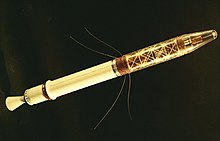User:Bandideux/Sandbox/Explorer 1

Explorer 1 was the first satellite made and launched by the United States. Before the satellite was launched, the Soviet Union had already put two satellites into orbit, Sputnik 1 (which had already lost its orbit and fell to the Earth[1]) and Sputnik 2. It was launched on January 31, 1958. It stayed in orbit until 1970, when the atmosphere had pulled on the satellite enough that it fell back to Earth, in something called orbital decay.

Launch[change | change source]
The satellite was launched on January 31, 1958, from Cape Canaveral Missile Annex in Florida. It was launched on a Juno I rocket.

First a booster made from part of the Jupiter-C sounding rocket brought the satellite to a sub-orbital trajectory (which meant that it was not quite into orbit yet). Then it used many stages of solid rockets to bring it to orbit. First, 11 Sargent solid rockets fired. When they ran out, they separated and then 3 Sargent solid rockets fired. When they ran out, they separated and only 1 Sargent solid rocket fired, and stayed attached to the rest of the satellite. At this time, the satellite was in an orbit.
Scientific research[change | change source]
The satellite had an instrument for measuring cosmic rays (also known as a Geiger counter), many instruments to detect micrometeorite (very small meteorites), five temperature sensors, batteries, and many antennas to send the information back to Earth.
Something weird happened with the Geiger counter. Near perigee, the instrument was working fine. But near apogee, the instrument was not detecting anything. With the future Explorer 3, scientists realized that the radiation was so high that it saturated the counter. This high amount of radiation was caused by the Van Allen belts.
References[change | change source]
- ↑ "Sputnik 1 – NSSDC ID: 1957-001B". NSSDC Master Catalog. NASA.
